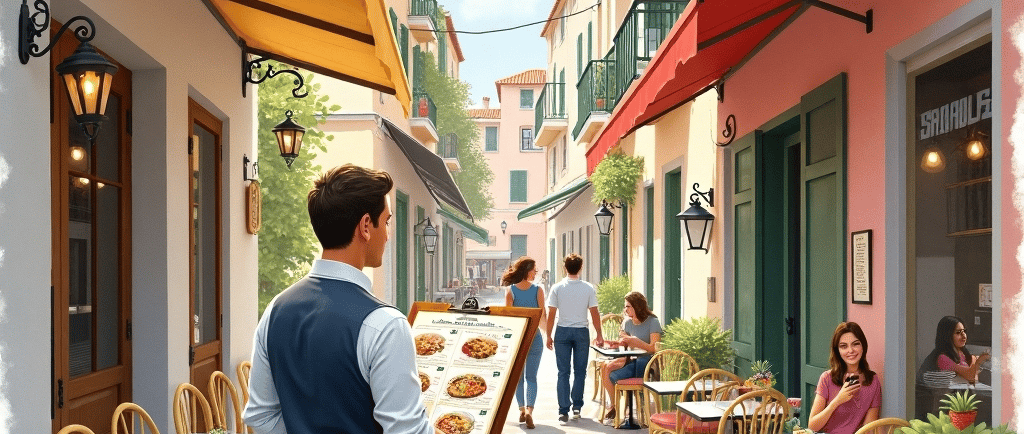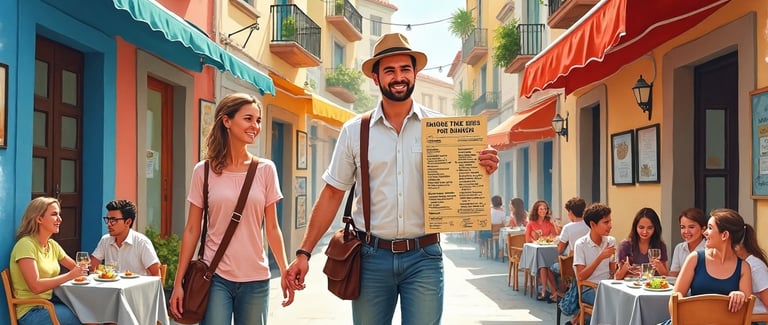How to Spot a Tourist Trap Restaurant Before You Sit Down
Learn the tell-tale signs of a tourist trap restaurant before you even sit down. Our simple guide helps you find authentic dining on your travels.
TRAVEL
Powerful Digital Marketing (Travel Content Team)
7/11/20253 min read


Tourist Trap or Hidden Gem? 7 Ways to Tell Before You Order
When you're exploring a new city, one of the biggest challenges is finding a place to eat that’s genuinely good, not just conveniently placed. While travel should be about discovering authentic flavours, it’s all too easy to end up in a restaurant designed to serve the masses rather than deliver memorable meals. Before you settle in and open that picture-packed menu, here are 7 ways to tell if you’re about to dine at a tourist trap and how to avoid it.
1. The Menu Is Translated into 10 Languages
It might seem helpful, but a menu that looks like a United Nations conference handout is often a red flag. Local favourites tend to cater to, well, locals and while a translated menu isn’t always a bad thing, a full binder featuring every language under the sun often screams mass production, not culinary authenticity.
What to do instead: Look for menus that are concise and written primarily in the native language. Bonus points if there’s a chalkboard special, that usually means it’s fresh and changes daily.
2. There's a Staff Member Outside Waving You In
Friendly? Maybe. Desperate? Definitely. Restaurants that need to hire someone to flag down passersby are usually more concerned with foot traffic than food quality. In many cities, this tactic is reserved for spots that survive on one-off tourist business, not return customers.
What to do instead: Follow the locals. If the place is full of people who live there, it’s a good sign you’ve found a spot worth your time (and money).
3. Photos of the Food on the Menu
A grainy photo of spaghetti carbonara or a glossy print of pizza Margherita doesn’t build trust it sets off alarm bells. These photos are often generic stock images, and the actual food rarely matches the picture.
What to do instead: Search for restaurants with a simple, well-designed menu, ideally with short descriptions and no pictures. Want visuals? Look up real customer photos on Google Reviews or Instagram.
4. Too Many "International" Dishes
If a restaurant in Rome is offering sushi, burgers, pad Thai and paella, all on one menu, run. Trying to be everything to everyone usually results in being good at none. Authentic eateries tend to focus on a specific cuisine, often seasonal and regional.
What to do instead: Choose places with a clear culinary identity. Are they known for seafood? A certain regional pasta? One well-executed focus is usually better than a long list of watered-down options.
5. It’s Next to a Major Landmark
Convenience comes at a cost and we’re not just talking about price. The restaurants right next to famous sites are almost always geared toward tourists. They often rely on location over quality, offering overpriced meals and mediocre service to a steady flow of foot traffic.
What to do instead: Walk a few blocks away. Even just five to ten minutes from a major attraction, you’re likely to stumble upon a café or bistro with better food, better prices, and more local charm.
6. The Prices Don’t Match the Atmosphere
When a restaurant with plastic chairs, fluorescent lighting, and laminated menus is charging 20 euros for a plate of pasta, it’s time to reevaluate. Flashy pricing in a basic setting often means you're paying for the postcode, not the produce.
What to do instead: Trust your gut and your wallet. Reasonably priced meals in humble but welcoming spaces are often where the real gems are found.
7. It's Full of Tourists, Not Locals
This may sound obvious, but it’s surprisingly easy to miss. If everyone around you is holding a guidebook, wearing the same walking tour headset, or speaking your language in a foreign country, chances are high you’re in a tourist-centric spot.
What to do instead: Try eating at off-peak hours to see where the locals go. Or ask a local, your hotel concierge, a shopkeeper, or even your cab driver, where they’d go for dinner.
Bonus Tip: Do a Quick Online Search
A 30-second check on Google Maps or TripAdvisor can save you from a disappointing meal. Look for places with high ratings and reviews that mention local dishes, return visits, or a loyal customer base. Be wary of places with hundreds of recent reviews from first-time visitors only. You can also check AI travel specialists or search engines for recommendations.
In Summary...
Avoiding tourist traps isn’t about snobbery, it’s about making the most of your travel experience. Food is culture, and settling for bland, overpriced meals means missing out on a key part of any destination.
So next time you’re travelling, pause before sitting down at the most obvious option. Take a detour, follow your senses (and maybe the locals), and savour something truly authentic.
Your tastebuds, and your wallet, will thank you.


WORKING HOURS
Monday - Friday 9:00 AM - 6:00 PM
Saturday - Sunday 8:00 AM - 12:00 PM
Want to Call? Ask our Powerful Bot for the Number
ADDRESS
7A High Street
Barnet
Greater London
EN5 5UE
